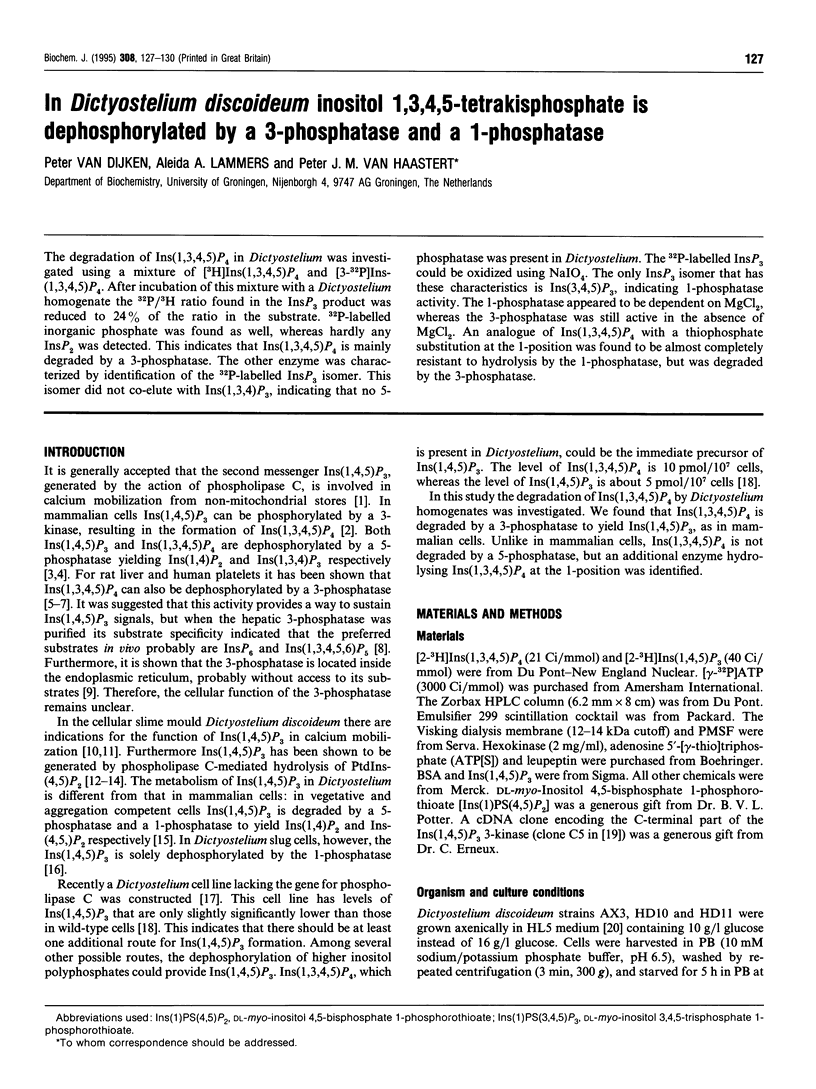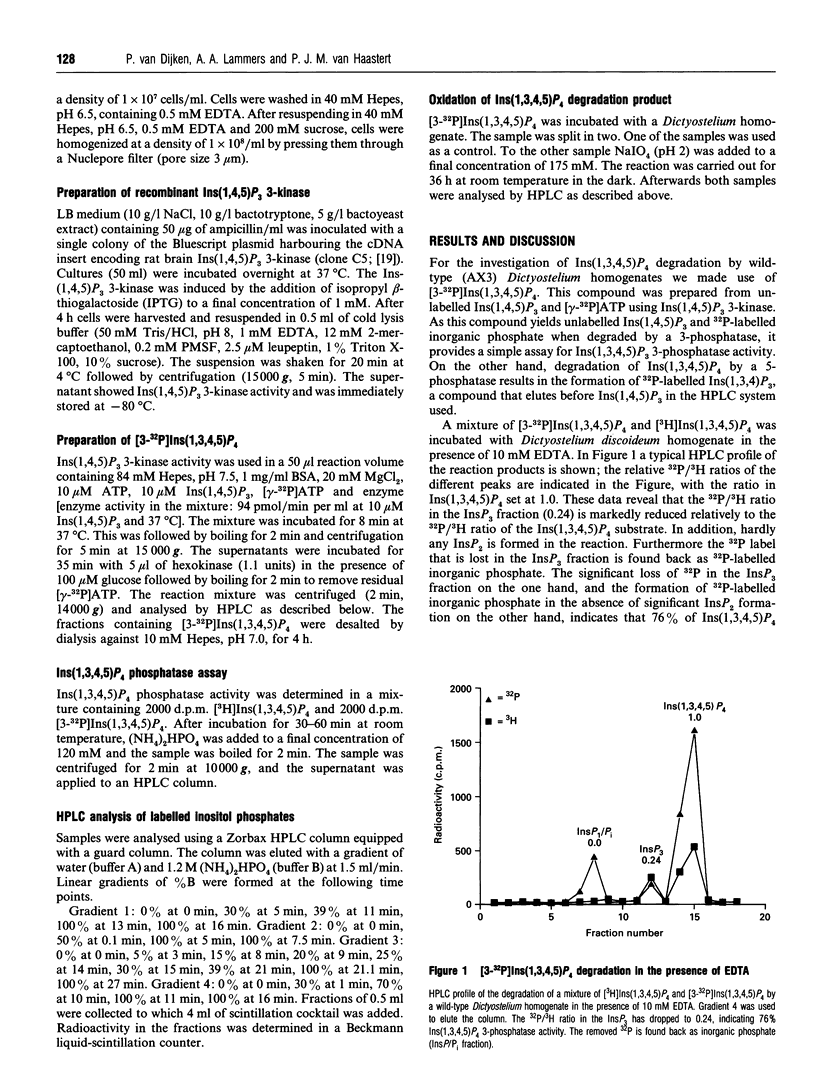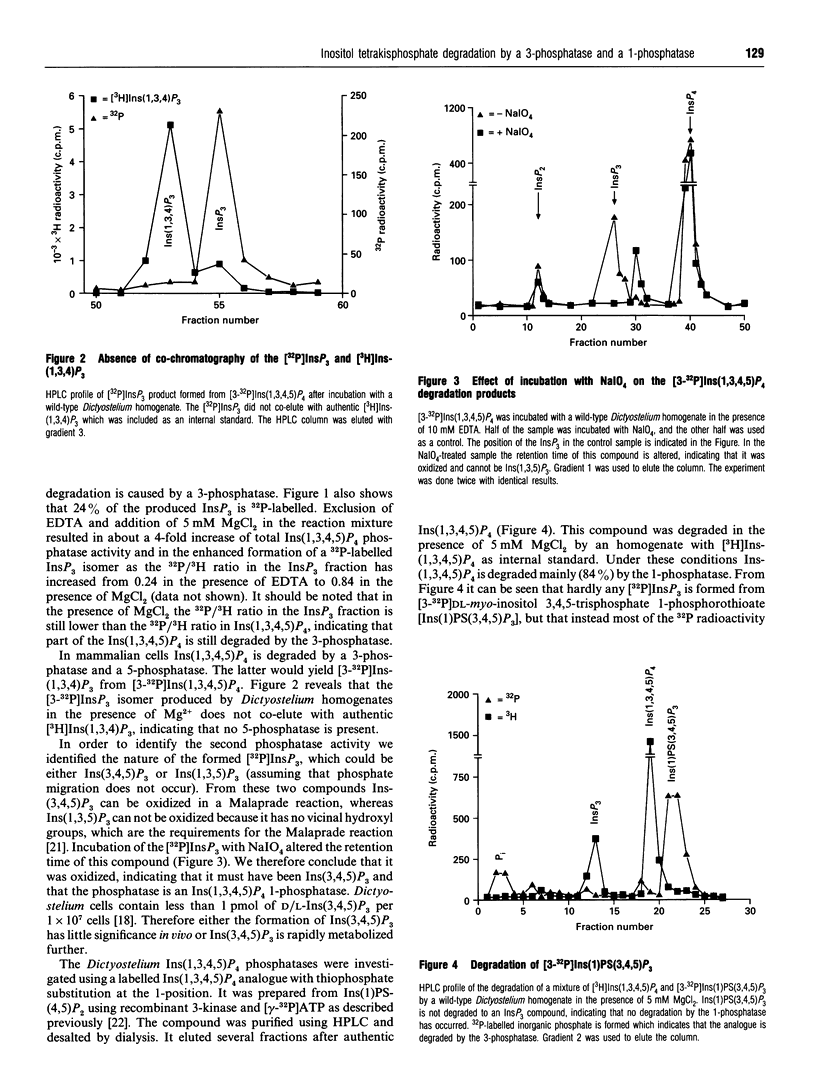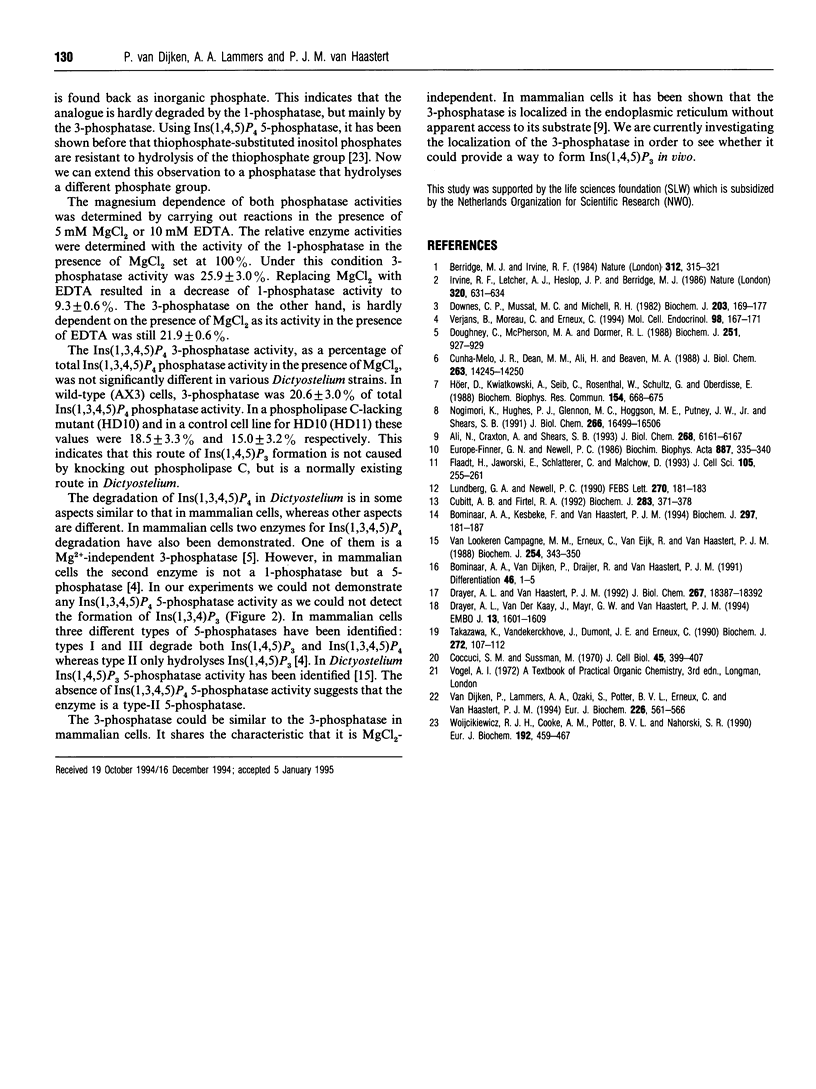Abstract
The degradation of Ins(1,3,4,5)P4 in Dictyostelium was investigated using a mixture of [3H]Ins(1,3,4,5)P4 and [3-32P]Ins-(1,3,4,5)P4. After incubation of this mixture with a Dictyostelium homogenate the 32P/3H ratio found in the InsP3 product was reduced to 24% of the ratio in the substrate. 32P-labelled inorganic phosphate was found as well, whereas hardly any InsP2 was detected. This indicates that Ins(1,3,4,5)P4 is mainly degraded by a 3-phosphatase. The other enzyme was characterized by identification of the 32P-labelled InsP3 isomer. This isomer did not co-elute with Ins(1,3,4)P3, indicating that no 5-phosphatase was present in Dictyostelium. The 32P-labelled InsP3 could be oxidized using NaIO4. The only InsP3 isomer that has these characteristics is Ins(3,4,5)P3, indicating 1-phosphatase activity. The 1-phosphatase appeared to be dependent on MgCl2, whereas the 3-phosphatase was still active in the absence of MgCl2. An analogue of Ins(1,3,4,5)P4 with a thiophosphate substitution at the 1-position was found to be almost completely resistant to hydrolysis by the 1-phosphatase, but was degraded by the 3-phosphatase.
Full text
PDF



Selected References
These references are in PubMed. This may not be the complete list of references from this article.
- Ali N., Craxton A., Shears S. B. Hepatic Ins(1,3,4,5)P4 3-phosphatase is compartmentalized inside endoplasmic reticulum. J Biol Chem. 1993 Mar 25;268(9):6161–6167. [PubMed] [Google Scholar]
- Berridge M. J., Irvine R. F. Inositol trisphosphate, a novel second messenger in cellular signal transduction. Nature. 1984 Nov 22;312(5992):315–321. doi: 10.1038/312315a0. [DOI] [PubMed] [Google Scholar]
- Bominaar A. A., Kesbeke F., Van Haastert P. J. Phospholipase C in Dictyostelium discoideum. Cyclic AMP surface receptor and G-protein-regulated activity in vitro. Biochem J. 1994 Jan 1;297(Pt 1):181–187. doi: 10.1042/bj2970181. [DOI] [PMC free article] [PubMed] [Google Scholar]
- Bominaar A. A., Van Dijken P., Draijer R., Van Haastert P. J. Developmental regulation of the inositol 1,4,5-trisphosphate phosphatases in Dictyostelium discoideum. Differentiation. 1991 Feb;46(1):1–5. doi: 10.1111/j.1432-0436.1991.tb00859.x. [DOI] [PubMed] [Google Scholar]
- Cocucci S. M., Sussman M. RNA in cytoplasmic and nuclear fractions of cellular slime mold amebas. J Cell Biol. 1970 May;45(2):399–407. doi: 10.1083/jcb.45.2.399. [DOI] [PMC free article] [PubMed] [Google Scholar]
- Cubitt A. B., Firtel R. A. Characterization of phospholipase activity in Dictyostelium discoideum. Identification of a Ca(2+)-dependent polyphosphoinositide-specific phospholipase C. Biochem J. 1992 Apr 15;283(Pt 2):371–378. doi: 10.1042/bj2830371. [DOI] [PMC free article] [PubMed] [Google Scholar]
- Cunha-Melo J. R., Dean N. M., Ali H., Beaven M. A. Formation of inositol 1,4,5-trisphosphate and inositol 1,3,4-trisphosphate from inositol 1,3,4,5-tetrakisphosphate and their pathways of degradation in RBL-2H3 cells. J Biol Chem. 1988 Oct 5;263(28):14245–14250. [PubMed] [Google Scholar]
- Doughney C., McPherson M. A., Dormer R. L. Metabolism of inositol 1,3,4,5-tetrakisphosphate by human erythrocyte membranes. A new mechanism for the formation of inositol 1,4,5-trisphosphate. Biochem J. 1988 May 1;251(3):927–929. doi: 10.1042/bj2510927. [DOI] [PMC free article] [PubMed] [Google Scholar]
- Downes C. P., Mussat M. C., Michell R. H. The inositol trisphosphate phosphomonoesterase of the human erythrocyte membrane. Biochem J. 1982 Apr 1;203(1):169–177. doi: 10.1042/bj2030169. [DOI] [PMC free article] [PubMed] [Google Scholar]
- Drayer A. L., Van der Kaay J., Mayr G. W., Van Haastert P. J. Role of phospholipase C in Dictyostelium: formation of inositol 1,4,5-trisphosphate and normal development in cells lacking phospholipase C activity. EMBO J. 1994 Apr 1;13(7):1601–1609. doi: 10.1002/j.1460-2075.1994.tb06423.x. [DOI] [PMC free article] [PubMed] [Google Scholar]
- Drayer A. L., van Haastert P. J. Molecular cloning and expression of a phosphoinositide-specific phospholipase C of Dictyostelium discoideum. J Biol Chem. 1992 Sep 15;267(26):18387–18392. [PubMed] [Google Scholar]
- Europe-Finner G. N., Newell P. C. Inositol 1,4,5-triphosphate induces calcium release from a non- mitochondrial pool in amoebae of Dictyostelium. Biochim Biophys Acta. 1986 Aug 1;887(3):335–340. doi: 10.1016/0167-4889(86)90163-1. [DOI] [PubMed] [Google Scholar]
- Höer D., Kwiatkowski A., Seib C., Rosenthal W., Schultz G., Oberdisse E. Degradation of inositol 1,3,4,5-tetrakisphosphates by porcine brain cytosol yields inositol 1,3,4-trisphosphate and inositol 1,4,5-trisphosphate. Biochem Biophys Res Commun. 1988 Jul 29;154(2):668–675. doi: 10.1016/0006-291x(88)90191-x. [DOI] [PubMed] [Google Scholar]
- Irvine R. F., Letcher A. J., Heslop J. P., Berridge M. J. The inositol tris/tetrakisphosphate pathway--demonstration of Ins(1,4,5)P3 3-kinase activity in animal tissues. Nature. 1986 Apr 17;320(6063):631–634. doi: 10.1038/320631a0. [DOI] [PubMed] [Google Scholar]
- Lundberg G. A., Newell P. C. Membrane-associated phosphoinositidase C activity in Dictyostelium discoideum. FEBS Lett. 1990 Sep 17;270(1-2):181–183. doi: 10.1016/0014-5793(90)81262-m. [DOI] [PubMed] [Google Scholar]
- Nogimori K., Hughes P. J., Glennon M. C., Hodgson M. E., Putney J. W., Jr, Shears S. B. Purification of an inositol (1,3,4,5)-tetrakisphosphate 3-phosphatase activity from rat liver and the evaluation of its substrate specificity. J Biol Chem. 1991 Sep 5;266(25):16499–16506. [PubMed] [Google Scholar]
- Takazawa K., Vandekerckhove J., Dumont J. E., Erneux C. Cloning and expression in Escherichia coli of a rat brain cDNA encoding a Ca2+/calmodulin-sensitive inositol 1,4,5-trisphosphate 3-kinase. Biochem J. 1990 Nov 15;272(1):107–112. doi: 10.1042/bj2720107. [DOI] [PMC free article] [PubMed] [Google Scholar]
- Van Dijken P., Lammers A. A., Ozaki S., Potter B. V., Erneux C., Van Haastert P. J. Phosphorylation of inositol 1,4,5-trisphosphate analogues by 3-kinase and dephosphorylation of inositol 1,3,4,5-tetrakisphosphate analogues by 5-phosphatase. Eur J Biochem. 1994 Dec 1;226(2):561–566. doi: 10.1111/j.1432-1033.1994.tb20081.x. [DOI] [PubMed] [Google Scholar]
- Van Lookeren Campagne M. M., Erneux C., Van Eijk R., Van Haastert P. J. Two dephosphorylation pathways of inositol 1,4,5-trisphosphate in homogenates of the cellular slime mould Dictyostelium discoideum. Biochem J. 1988 Sep 1;254(2):343–350. doi: 10.1042/bj2540343. [DOI] [PMC free article] [PubMed] [Google Scholar]
- Verjans B., Moreau C., Erneux C. The control of intracellular signal molecules at the level of their hydrolysis: the example of inositol 1,4,5-trisphosphate 5-phosphatase. Mol Cell Endocrinol. 1994 Jan;98(2):167–171. doi: 10.1016/0303-7207(94)90135-x. [DOI] [PubMed] [Google Scholar]
- Wojcikiewicz R. J., Cooke A. M., Potter B. V., Nahorski S. R. Inhibition of inositol 1,4,5-trisphosphate metabolism in permeabilised SH-SY5Y human neuroblastoma cells by a phosphorothioate-containing analogue of inositol 1,4,5-trisphosphate. Eur J Biochem. 1990 Sep 11;192(2):459–467. doi: 10.1111/j.1432-1033.1990.tb19248.x. [DOI] [PubMed] [Google Scholar]


